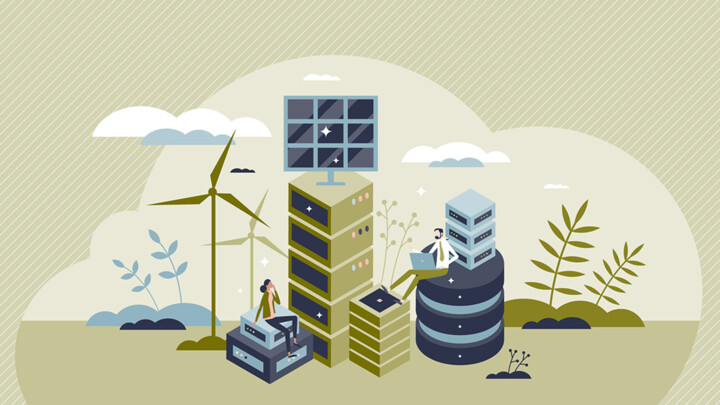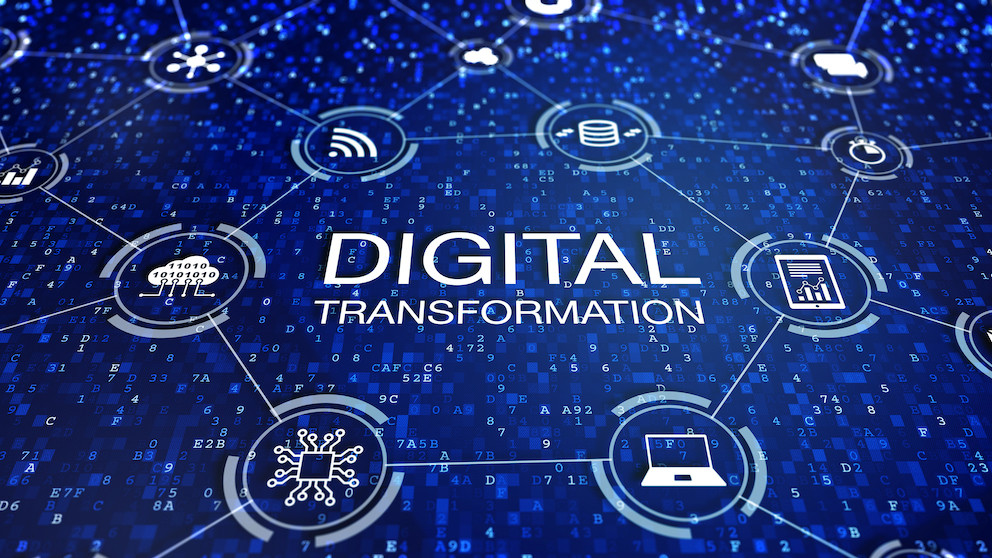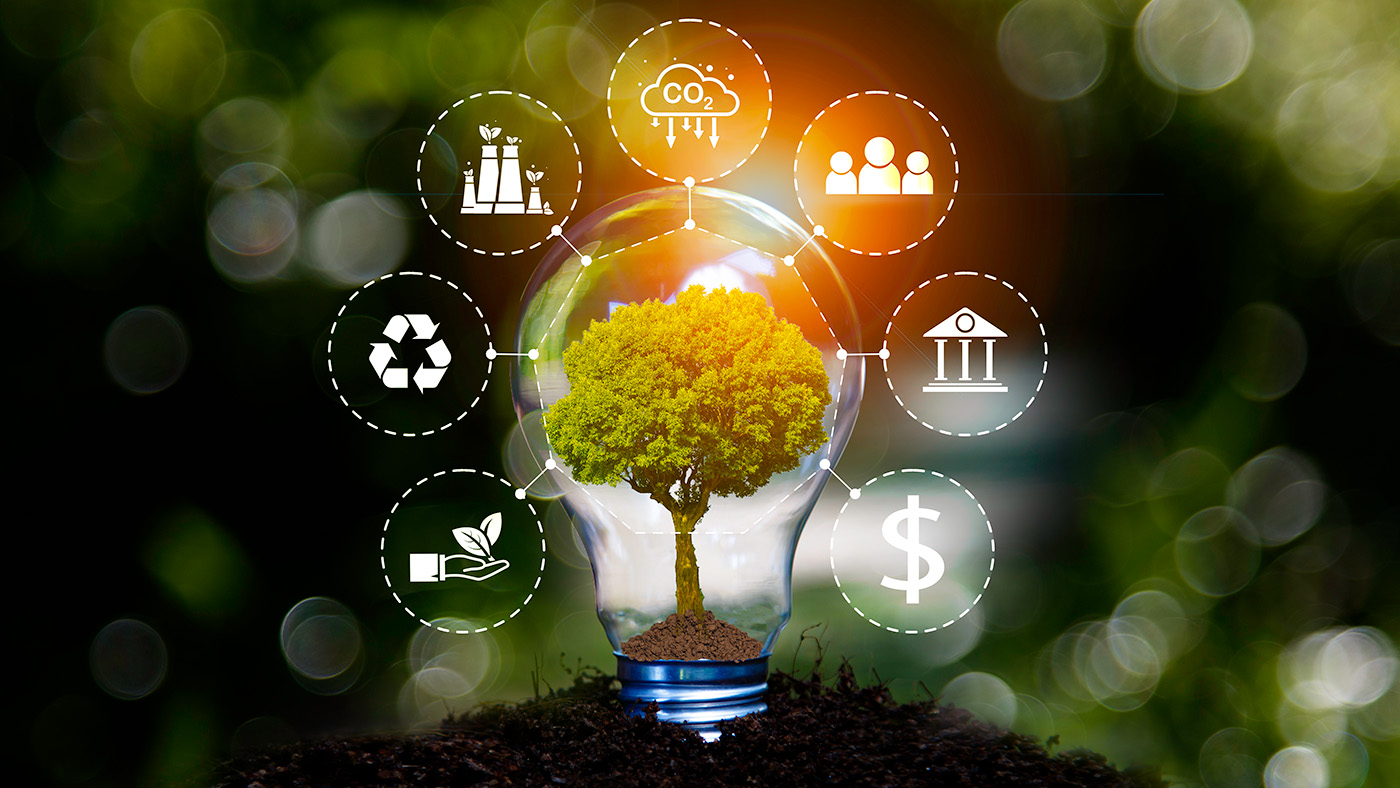Sustainable Digitalization through Energy-Efficient Data Centers
Roland Broch, Senior Project Manager for Digital Infrastructures at eco Association, explains the vital role of digital infrastructure and energy-efficient data centers in achieving sustainability goals.

©VectorMine | istockphoto.com
The relationship between digitalization and sustainability is becoming more symbiotic. Digital infrastructure, and data centers in particular, play an integral role in achieving sustainability goals. A recent eco Association survey shows that over half (53.3%) of 18-29 year-olds in Germany believe that digital technologies and applications can help to tackle climate change. Alexander Rabe, Managing Director of the eco Association, comments: “The generation that will be most affected by climate change believes that digitalization will play a significant role in shaping their future.”
The study “Digital Transformation for More Sustainability”, conducted by eco with Arthur D. Little and the Alliance for the Strengthening of Digital Infrastructures in Germany, quantifies this impact of digital technologies on sustainability.
The findings are compelling: by 2050, consistent use of digital technologies could lead to a reduction of 163 megatons of CO2 emissions across various sectors. Improvements in data storage and transmission could decrease CO2 emissions by another 104 megatons. This represents up to 30 percent of the forecasted CO2 emissions for Germany by 2050, illustrating a significant potential impact on national carbon reduction targets.
Moreover, eco’s report shows digital infrastructures not only consume energy but also significantly offset this consumption by enabling broader energy efficiencies across multiple sectors. Oliver Süme, Chair of the eco Board, and Dr. Béla Waldhauser from Telehouse & the Alliance for the Strengthening of Digital Infrastructures in Germany, highlight that digital tech is the key to significantly reducing Germany’s CO₂ emissions. They provide examples such as smart meters, which continuously monitor energy consumption, and connected mobility solutions that could reduce CO2 emissions by 14 megatons by 2030.
Integrating smart city concepts could potentially save 80,000 tons of CO2 per day by 2030 in urban areas. For the rural and industrial sectors, the introduction of IoT applications is projected to cut CO2 emissions by 37 percent and 39 percent respectively by 2050. With this potential in mind, let’s examine the pivotal role that data centers play in this sustainable transformation.
Data centers – key to sustainable digital transformation
Data centers are crucial in the digital transformation of the economy and society. They are part of an ecosystem that makes communication possible via email, online shopping, smart production lines, and the use of artificial intelligence (AI).
“Without data centers, there is no data; without data, there is no digitalization,” emphasized Dr. Walter Fischedick from the Hessian Ministry for Digitalization and Innovation at the Data Center Expert Summit 2024, hosted by the eco Association. The rise of digitalization and artificial intelligence has led to a significant increase in data volumes, driving up the demand for computing power – a tenfold increase in the last decade. Meanwhile, however, the energy consumption per gigabit in data centers was 12 times lower in 2020 than in 2010. This underlines the importance of implementing energy-efficient practices and technologies in data centers.
With the critical necessity of data centers clearly outlined, let’s explore how the industry is innovating to optimize energy use.
Innovative energy optimization
The data center industry is focusing on improving energy efficiency to reduce CO2 emissions cost-effectively. Utilizing waste heat from data centers has significant potential. Data centers generate substantial waste heat that can be repurposed for, e.g., adjacent office buildings, local and district heating networks, or greenhouses and vertical farming. As Dr. Béla Waldhauser from Telehouse & the eco Alliance puts it, “heating via the Internet” saves resources in the form of fossil fuels and, at the same time, reduces energy costs.
Best practice examples from data centers in Portugal, Spain, Sweden, and Germany show how energy can be saved using the technologies and applications already available on the market.
At a recent eco Association event on energy storage technologies for the data center industry at the University of Bayreuth, further innovative technologies were presented, like the use of quantum computers to improve batteries and fuel cells, chemical-free and durable supercapacitors that could replace batteries in the future, and versatile heat pumps that utilize groundwater or the exhaust air from data centers as a heat source.
Ice energy storage, water cooling, geothermal energy, and increased power density in server racks are also promising approaches to optimizing energy usage. Additionally, long-term energy storage and hydrogen technologies are being further developed for practical implementation in various industries. Another transformative element comes into play as we consider these advancements in energy optimization: artificial intelligence.
AI is helping make data centers more energy-efficient
While classic engineering measures contribute to sustainable data center operation, such as optimizing the number of ventilation panels in the cold aisles or adjusting the chillers’ setpoints depending on the ambient temperature and the resulting reduction in evaporator temperature, the use of artificial intelligence (AI) offers huge potential for energy optimization.
Volker Ludwig of Digital Realty and Deputy Spokesperson for the Alliance for the Strengthening of Digital Infrastructures in Germany gives an example of how AI is helping to save energy in data centers. It detects irregularities such as clogged filters or leaking valves and makes suggestions for adjusting operating settings. The DC2HEAT project at the Borderstep Institute uses AI to better coordinate the supply and demand of heat and to operate heating networks more efficiently, as Dr. Ralph Hintemann explains in an interview with the eco Association. The potential of AI extends beyond current applications, setting the stage for future innovations in data center energy management.
Drivers of sustainable digital transformation
As we advance towards a more digital and connected world, the significance of data centers in driving sustainability forward cannot be overstated. The imperative now is to build upon the key findings and insights outlined in this article. This includes the crucial role data centers play in leveraging digital technologies to reduce CO2 emissions and enhance energy efficiencies across various sectors. The innovative strategies highlighted underscore the industry’s commitment to sustainable practices, such as utilizing waste heat, incorporating advanced energy optimization technologies, and harnessing the power of AI for enhanced operational efficiency.
Moving forward, the challenge and opportunity lie in further enhancing the energy efficiency of data centers and expanding their capacity to support sustainable initiatives across all sectors of the economy. By continuing to innovate and implement such strategies, data centers can remain at the forefront of driving sustainable digital transformation for a greener future.
Roland Broch is Senior Project Manager Digital Infrastructures and the contact person for the Data Center Expert Group at eco – Association of the Internet Industry.





